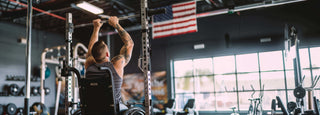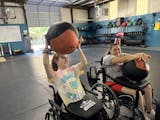Adaptive Fitness Isn’t Just Wheelchairs
I would argue that ninety percent of the people we speak with when they hear adaptive fitness think of wheelchair users. When you search for adaptive fitness online you will almost always find a bunch of pictures of people in wheelchairs. But, the vast majority of people who need adaptive fitness will never need a wheelchair.
Neurologically Impaired
In our work in adaptive fitness, the largest cohort of people we work with are neurologically impaired. In its most basic definition, neurological impairments are nervous system issues. There are far too many ways that these issues express themselves and how they affect day-to-day life, but the most common are ataxia or a lack of balance and coordination.
Visually Impaired
Visually impaired, or “blind” fitness enthusiasts are another group we get the pleasure of working with. When you hear someone is blind you immediately think of pitch black and no sight. That is true for many of the visually impaired fitness enthusiasts we know, but a great many more have some contrast or light that they can make out.
High Contrast Products
That is why we make high-contrast items like White Jump Ropes, Barbell Markers, or White Medicine Balls. Most gym settings have black rubber floors or are in dark spaces in general. If you are throwing a medicine ball to a target above your head, with limited visual acuity, you want every advantage you can get.
That’s also why we make White Jumps ropes so that when the user leaves it on the ground, the high contrast is easier to pick up when they go back to it. The barbell markers are used so that when placing your hands on a barbell you pick it up in the most balanced position. If you have ever tried picking up an unbalanced item you have felt what it’s like to lift an unbalanced barbell.
Short Stature
Another group that rarely is mentioned when I mention adaptive fitness is the Short Stature group. Whether it be Dwarfism, or just the shorter spectrum of life most gym equipment is not designed for you. It would be hard to manufacture products that meet every need, that’s why we started Equip Products.
Adapting Existing Products for Use
An easy example is the Concept2 Ski Erg. The overall height is seven feet and the handles for the erg retract to the top of the machine at about six and half feet. We offer a very simple product called The Handle Hooks for $10.00 on our website so that you can hook the Ski Erg handles on the side of the device at about four feet. This is a simple convenient adaption that almost every gym in the world could use.
Now You Can Ride A Bike!
Another aha moment for us was the use of bikes in the gym. It never occurred to me that most of the Short Stature athletes we work with cannot use a bike the way they are manufactured. If your total leg length is eighteen inches and the bike pedals are twenty-four inches you have an issue. The Adaptive Bike Handles for the Rogue® Echo Bike and The Assault Fitness Bike make for an easy adaption that allows them to use the handles from the other side of the bike. We also make a product called the Flip monitor interface that allows you to turn and flip the monitors on these bikes so that the user can see their own progress.
Older Adults Thrive With Adaptive Fitness
The United States has never had a higher median age. Baby Boomers and their kids, whom some call echo boomers, are one of the largest groups of people in the country today and they are living longer. That’s great news for overall health, but how do you do you adapt your fitness over sixty, seventy, eighty, or ninety years old?
Joint Replacements
If you have had hip and knee replacements you would need to build a lot of strength before you start pounding those joints again. Maybe rather than jumping rope, you use a Multi Rope™. Rather than jumping, potentially tripping, or generally doing a skill you're not ready for, mimic the stimulus. Multi Ropes™ are ropes on jump rope handles in two pieces so that you move the same way, but you do not need to jump.
Seated Workouts to Start
Maybe you need to start your fitness journey in the seated position. Placing odd objects like a dumbbell on your lap can not only be uncomfortable, it can sometimes be dangerous. Bruising and potentially worse can happen to your legs and that stops your fitness journey quickly.
Protect Your Leg's
The LapMat™ is a cushion made specifically to protect your legs. It straps around your body and sits on your lap to protect you from whatever you're putting on your lap during fitness. Or maybe you’re not ready for the bike like our short-stature friends, use the aforementioned Bike Handles.
Heavier Individuals Need To Train Different
It’s no secret that we are larger than we ever have been and not in a healthy way. Our diets and lack of exercise are wreaking havoc on our bodies and more and more of us are using assistive devices just to get around the grocery store. Adaptive fitness can play a huge role in changing the mindset. For more information specifically about fitness over fifty see yesterday’s article Five Things I Learned About Weight Gain & Loss at Fifty.
How Does Adaptive Fitness Help Obese Individuals
What does adaptive fitness look like for someone who is severely overweight? When I was in that position, I could not even imagine doing a burpee, and frankly, I don’t love doing them now, but I do. Rather than trying to fit the athlete in the movement, how about changing the thinking? Start from a chair. Can you stand up without using your arms to assist you? If not, let’s work on that, getting up without using your hands. When you can stand from a chair just using your legs, start trying it from a plyo-box that sits lower than the chair. When you can do that, work on getting down to the floor and getting back up.
Everything Can Be Modified
We already discussed modified jump ropes and lap protection for the older adults; we can do the same for the severely overweight. Use a Multi Rope™ and a LapMat™. If you don’t have access to those products, cut a cheap jump rope in half, put a pillow on your lap, and start moving. There are literally hundreds of adaptations that we have used over the years, and there are a lot of resources available should you want to change your life with fitness.
Conclusion
Adaptive Fitness equipment is for wheelchair athletes, people with missing limbs, and a variety of obvious “disabilities”, and we are grateful for every one of these athletes, but we also want trainers, coaches, and anyone looking to get fit to know that there are tools available to help them. Adaptive fitness can benefit the people you interact with every day, and you might never think they would fall into the adaptive fitness category.
For more information on adaptive fitness and equipment, visit Equip Products.



